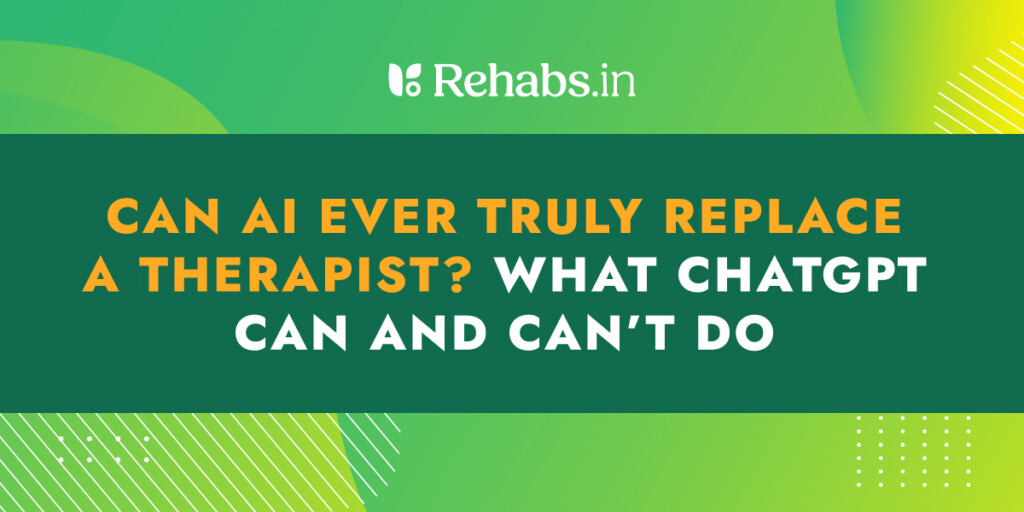Can AI Ever Truly Replace a Therapist? What ChatGPT Can and Can’t Do

In recent years, artificial intelligence has made its way into nearly every corner of our lives from helping us plan meals to writing emails. Now, AI is showing up in one of the most sensitive spaces of all: mental health. With tools like ChatGPT offering 24/7 emotional support, self-reflection prompts, and even therapy-style conversations, it’s natural to wonder, could AI ever take the place of a human therapist?
It’s an exciting and unsettling question. On one hand, AI can make mental health support more accessible, especially for those who can’t afford therapy or feel hesitant to seek help. On the other hand, therapy isn’t just about problem-solving, it’s about connection, empathy, and being seen in your most vulnerable moments.
In this blog, we’ll explore what AI can actually do when it comes to mental health support, where its limits lie, and why the human element in therapy remains irreplaceable. Whether you’re a curious user, a mental health professional, or someone navigating your own healing journey, this is for you.
What AI Like ChatGPT Can Do in Mental Health Support
Let’s start with the good news AI can be surprisingly helpful when it comes to mental health. While it’s not a licensed therapist, tools like ChatGPT can still support people in meaningful ways. Here’s how:
Provide mental health information
AI can explain psychological concepts in simple terms whether you’re trying to understand anxiety, burnout, or how trauma affects the brain. It’s like having a psychology explainer in your pocket.
Offer reflection prompts and journaling ideas
Need help untangling your thoughts? AI can guide you through reflective questions, journaling prompts, or even gentle CBT-style exercises to help you think differently about a situation.
Suggest coping strategies
From breathing techniques to grounding exercises, AI can walk you through basic tools for stress, anxiety, and overwhelm especially when you’re not sure where to start.
Be there anytime, anywhere
One of AI’s biggest strengths? It doesn’t sleep. It can respond at 2 a.m. when you’re spiraling or just need to “talk” without judgment. That kind of accessibility can feel comforting.
Reduce the stigma around help-seeking
For those hesitant to open up to a therapist, chatting with AI might feel like a safer first step. It can help people dip their toes into mental health support in a low-pressure way.
What AI Can’t Do
While AI can be helpful, there’s a clear line it can’t (and shouldn’t) cross and that’s where real therapy begins.
It doesn’t truly feel with you
A therapist doesn’t just listen to what you say they notice how you say it. The pause before you speak, the shift in your tone, the tears you’re trying to hold back. AI can’t pick up on those subtle, human cues.
It can’t offer emotional attunement
One of the most healing parts of therapy is feeling emotionally held by someone who gets it. A therapist mirrors your feelings, sits with your pain, and helps you feel less alone. AI, no matter how well-worded, is still just responding based on patterns not empathy.
It can’t manage risk or crisis
If someone is in crisis thinking about harming themselves, experiencing abuse, or dealing with a mental health emergency AI is not equipped to intervene or ensure safety. This is where professional training, ethical responsibility, and human judgment are non-negotiable.
It won’t challenge you in the way a therapist can
Therapy isn’t always comfortable. A good therapist gently confronts your blind spots, helps you notice patterns, and supports you in doing hard emotional work. AI tends to stay agreeable and non-confrontational. It’s just not designed to challenge or emotionally stretch you.
It doesn’t build a real relationship
Healing often happens in the relationship with the therapist. Trust, rupture, repair, vulnerability these are things you experience and work through together. No AI can replicate that process.
What AI Can’t Replicate
So what makes therapy with a real person so different? It’s not just the tools or techniques, it’s how they’re offered, and who offers them.
Therapists offer emotional presence. They don’t just hear your words they feel with you. They notice the long pauses, the trembling voice, the emotions you’re not saying out loud. AI can respond, but it can’t truly attune. A therapist can gently ask, “What just happened there?” in a way that helps you explore what’s underneath.
Human connection itself is healing. The safety, trust, and care you build with a therapist often becomes the foundation for real change. That kind of relationship can’t be built with a chatbot.
Therapists also use their intuition based on experience, context, and emotional cues to meet you where you are. They hold space for the messy, raw, complicated parts of being human.
Can AI Be a Complement to Therapy?
While AI can’t replace therapy, it can definitely play a supportive role if used mindfully. For starters, AI can be a great in-between tool. It can offer journaling prompts, mindfulness exercises, or reminders of things you’re working on in therapy. Think of it like a bridge between sessions.
It can also help people who aren’t ready for therapy yet. Chatting with an AI might feel safer for someone who’s just starting to explore their thoughts and feelings. It can reduce the fear of opening up.
In areas where therapists are hard to find or therapy is too expensive AI tools can help fill some of the gap. They’re not perfect, but they’re better than having no support at all. Even for therapists, AI can assist with tasks like writing notes, organizing thoughts, or sharing resources with clients. It’s not the therapist, but it can be a useful assistant behind the scenes.
Ethical Considerations & User Responsibility
First, know what it is (and isn’t). AI tools like ChatGPT are not trained therapists. They don’t have clinical judgment, lived experience, or the ability to respond to emergencies. They’re trained on text not emotions or ethical codes.
Second, privacy matters. When you’re sharing personal things, even with a bot, you should always ask: Where is this information going? Is it being stored? Who might access it?
It’s also important to be cautious about misinformation. While AI tries to be accurate, it can occasionally give incorrect or outdated advice. It’s not a substitute for professional mental health guidance, especially when the stakes are high.
And finally, don’t expect too much. If you’re in deep emotional pain, facing a crisis, or dealing with trauma, please don’t rely on AI alone. Reach out to a therapist, counselor, or crisis line. You deserve real support from a real person.
Will AI Replace Therapists? A Realistic Answer
Short answer? No.
Long answer? AI can be a helpful addition to mental health support but it can’t replace the human connection, empathy, and trust that therapy is built on. AI might evolve, but therapy is more than a conversation, it’s a connection. And for now, that’s something only humans can offer.
Conclusion
AI has opened up exciting possibilities in mental health support it can educate, guide, and even comfort to an extent. But real healing often happens in relationship, in the presence of another human who listens not just with their mind, but with their heart. While tools like ChatGPT can complement therapy and increase access, they’re not a substitute for the safety, depth, and connection that a therapist provides. In the end, AI can assist but it’s the human connection that truly heals.
Sources:
American Psychological Association. (2025, March). Using generic AI chatbots for mental health support. APA Services. https://www.apaservices.org/practice/business/technology/artificial-intelligence-chatbots-therapists
AlMakinah, R., Norcini-Pala, A., Disney, L., & Canbaz, M. A. (2024, September 17). Enhancing mental health support through human-AI collaboration: Toward secure and empathetic AI-enabled chatbots. arXiv. https://arxiv.org/abs/2410.02783
Brown, J. E. H., & Halpern, J. (2021). AI chatbots cannot replace human interactions in the pursuit of more inclusive mental healthcare. SSM – Mental Health. https://doi.org/10.1016/j.ssmmh.2021.100017
Carter, G. (2025, May 8). My AI therapist saved my relationship—and helped put a stop to our endless fighting. New York Post. https://nypost.com/2025/05/08/lifestyle/ai-therapist-saved-couples-relationship/
Jeyaraman, M. M., et al. (2023). Ethical considerations in the use of artificial intelligence in mental health. The Egyptian Journal of Neurology, Psychiatry and Neurosurgery, 59(1), 1–3. https://ejnpn.springeropen.com/articles/10.1186/s41983-023-00735-2
Raczka, R. (2025, May 11). AI therapists can’t replace the human touch. The Guardian. https://www.theguardian.com/society/2025/may/11/ai-therapists-cant-replace-the-human-touch
Saha, K., Jain, Y., & De Choudhury, M. (2025, April 12). Linguistic comparison of AI- and human-written responses to online mental health queries. arXiv. https://arxiv.org/abs/2504.09271
Song, I., Pendse, S. R., Kumar, N., & De Choudhury, M. (2024, January 25). The typing cure: Experiences with large language model chatbots for mental health support. arXiv. https://arxiv.org/abs/2401.14362
Wykes, T. (2025, May 7). ‘It cannot provide nuance’: UK experts warn AI therapy chatbots are not safe. The Guardian. https://www.theguardian.com/technology/2025/may/07/experts-warn-therapy-ai-chatbots-are-not-safe-to-use














